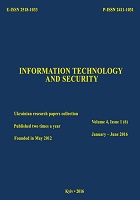Distribution models of information resources in ACS special purpose
DOI:
https://doi.org/10.20535/2411-1031.2016.4.1.96021Keywords:
Information resource, mathematical model, information and telecommunications network, automatic control system, distributed data.Abstract
In article are considered the principles of creation of mathematical models allowing to distribute optimum information resource of system according to the chosen criterion. The analysis of features planning for distribution an information resource is carried out to ACS of a special purpose. On the basis of the carried out analysis the task of development the model based on the relevant structure of the schedule system considering restrictions specific for considered by ACS is formulated. Two options of mathematical distribution model of information blocks on the distributed knots of the ACS basic information and telecommunication network for a special purpose are developed. ACS Special Features recorded in the developed model by introducing a utility function. The developed models are oriented on dynamic planning of distribution of an information resource. Dynamics of processes is discrete and depends on state change. This feature is especially urgent for execution of the transactions requiring a real time mode. It is supposed that the basic operating system has heterogeneous Hardware and software. In case of simulation of the processes happening in the appropriate information subsystems the multilayer system of processing and data storage is used. For this purpose in case of a system design or its upgrade the model of hierarchical separation of an information resource which can be considered rather independently and irrespective of interaction with external subscribers is created. Each following level of model hierarchical separation for information resource is characterized by increase in time for information access and reduction in cost to storage unit of data.
References
S. Agarwal, M. Kodialam, T.V. Lakshman, “Traffic engineering in software defined networks”, INFOCOM, in Proc. IEEE INFOCOM, Turin, Italy, 2013, pp. 2211-2219. doi: 10.1109/INFCOM.2013.6567024.
A.K.M. Baki, “Continuous monitoring of smart grid devices through multi protocol label switching”, IEEE Transactions on Smart Grid. vol. 5, iss. 3, pp. 1210-1215, May 2014. doi: 10.1109/TSG.2014.2301723.
I.V. Loginov, and E.V. Lebedenko, “Optimization of heterogeneous distributed computing system model for planning dataflow processing”, Information science and control systems, no. 3 (21), pp. 118-124, 2009.
H.A. Kuchuk. Information Technology Management integrated data flow in the information and telecommunication networks of critical purpose. Kharkiv, Ukraine: Plus generous homestead, 2013.
H.A. Kuchuk, and O.P. Davikoza, “Synthesis stratified structure of information integration of heterogeneous components component ACS Unified Armed Forces of Ukraine”, Science and Technology of the Air Force of Ukraine, no. 3 (12), pp. 154-158, 2013.
C. Schramm, A. Bieszczad, and B. Pagurek, “Application-oriented network modeling with mobile agents”, in Proc. of IEEE/IFIP Network Operations and Management Symposium NOM'98, New Orleans, Louisiana, USA, 1998, pp. 696-700. doi: 10.1109/NOMS.1998.654474.
W. Gentzsch, “Sun Grid Engine: towards creating a compute power grid”, in Proc. First IEEE/ACM International Symposium on Cluster Computing and the Grid, Brisbane, Australia, 2001, pp. 35-36. doi: 10.1109/CCGRID.2001.923173.
R. Subramanyan, J. Miguel-Alonso, and J. Fortes, “A scalable SNMP-based distributed monitoring system for heterogeneous network computing”, in Proc. of the 2000 ACM/IEEE Conference on Supercomputing (SC '00), Dallas, TX, USA, 2000, pp. 116-119. doi: 10.1109/SC.2000.10058.
R. Al-Ali, A. Hafid, O. Rana, and D. Walker, “An approach for QoS adaptation in service-oriented grids”, Concurrency and Computation: Practice and Experience Journal, vol. 16, no. 5, pp. 401-412, Mar. 2004. doi: 10.1002/cpe.819.
C. Dannewitz, D. Kutscher, B. Ohlman, S. Farrell, B. Ahlgren, and H. Karl, “Network of Information (NetInf) – An information-centric networking architecture”, Computer Communications, vol. 36, iss. 7, pp. 721-735, April 2013. doi: 10.1016/j.comcom.2013.01.009.
E.V. Azarenko, B.M. Gerasimov, and B.P. Shokhin. Design of automated control systems of computer networks. Sevastopol, Ukraine: Research Center “State Oceanarium” Ministry of Defence of Ukraineand the National Academy of Sciences of Ukraine, 2007.
Downloads
Published
How to Cite
Issue
Section
License
Copyright (c) 2020 Collection "Information technology and security"

This work is licensed under a Creative Commons Attribution 4.0 International License.
The authors that are published in this collection, agree to the following terms:
- The authors reserve the right to authorship of their work and pass the collection right of first publication this work is licensed under the Creative Commons Attribution License, which allows others to freely distribute the published work with the obligatory reference to the authors of the original work and the first publication of the work in this collection.
- The authors have the right to conclude an agreement on exclusive distribution of the work in the form in which it was published this anthology (for example, to place the work in a digital repository institution or to publish in the structure of the monograph), provided that references to the first publication of the work in this collection.
- Policy of the journal allows and encourages the placement of authors on the Internet (for example, in storage facilities or on personal web sites) the manuscript of the work, prior to the submission of the manuscript to the editor, and during its editorial processing, as it contributes to productive scientific discussion and positive effect on the efficiency and dynamics of citations of published work (see The Effect of Open Access).

